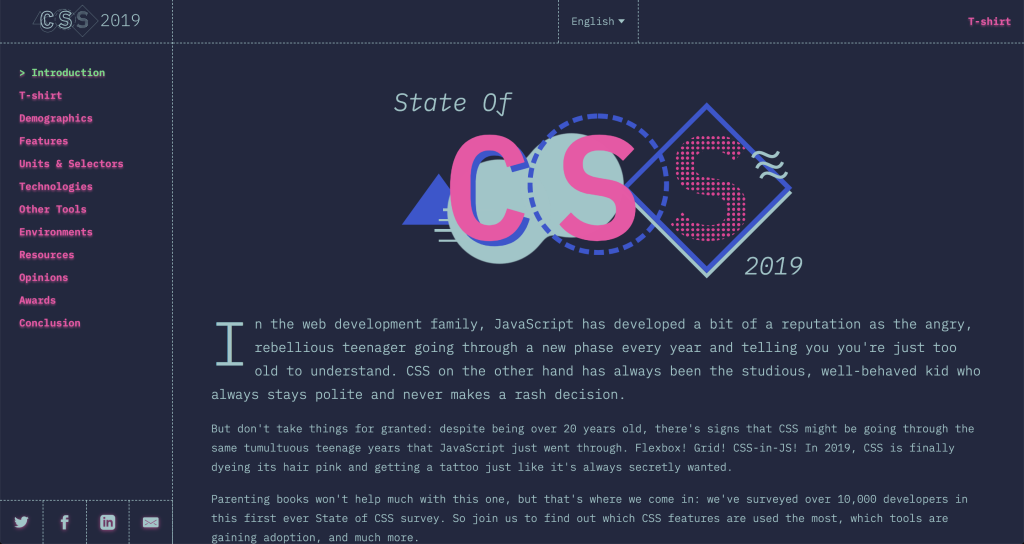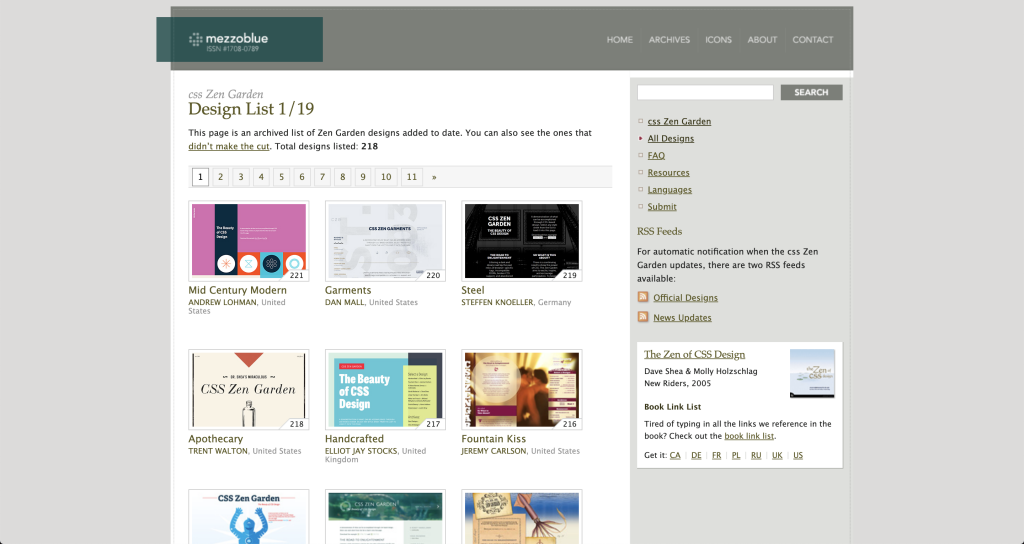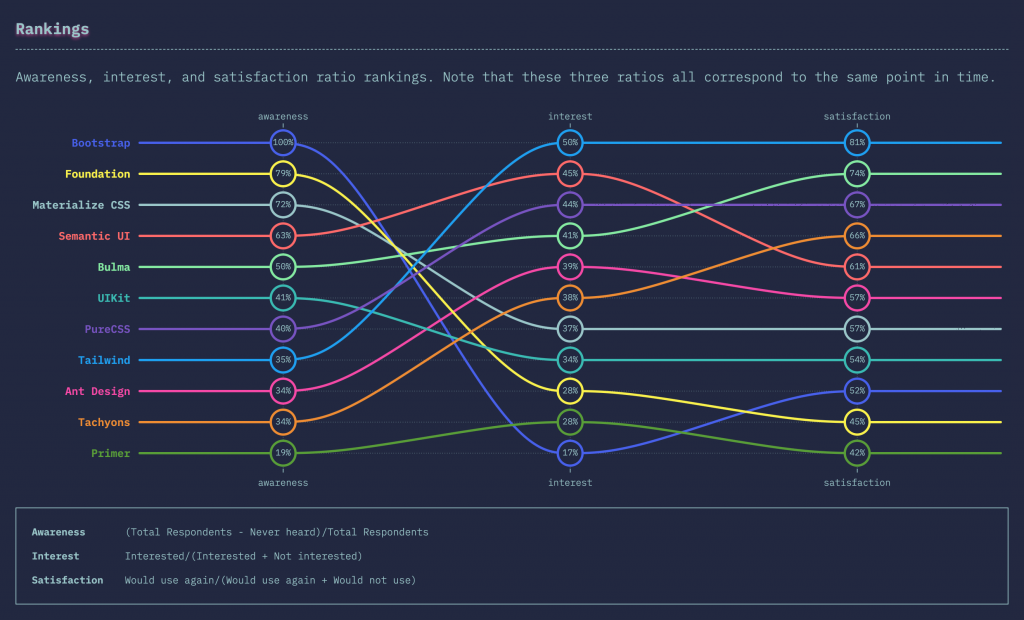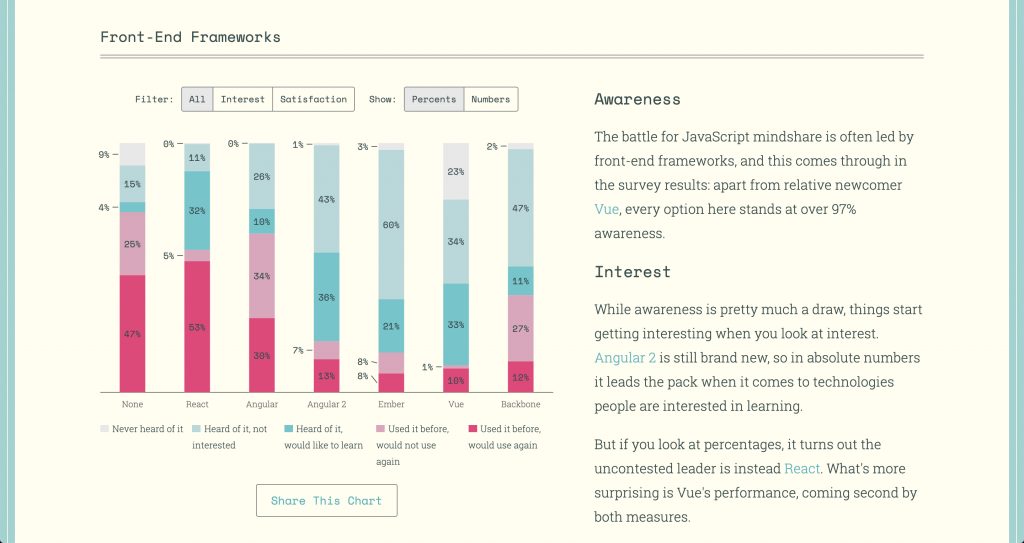Three Predictions From the State of CSS 2019 Survey
Running a developer survey like the State of CSS is a multi-stage process. First, you need to collect the data. Then, you process it into a usable shape. Finally, you come up with nifty ways to visualize it and release it to the world.
But then, once the dust settles and the traffic dies down comes my favorite part: actually thinking about the data. By taking a deeper look at our data, as well as observing how the community discussed our findings, three unexpected trends ended up coming into focus.
But first, some background for those not already familiar with the project.
I first started the State of JavaScript survey three years ago in 2016 as a way to answer my own uncertainties about the future of web development. At the time, JavaScript fatigue was running wild and I thought a comprehensive developer survey could prove itself the antidote.
Turns out I hit a nerve: that first survey turned out to be very popular, and our audience has grown each year since, along with the scope of the survey. (I was also joined by Raphael Benitte, creator of the Nivo.js dataviz library, to help me with data processing and visualization.) This year marks the first time we’re pivoting out into a new dimension, namely the not-so-simple world of CSS.

Prediction 1: CSS still has a lot of unexplored territory
One of the things we wanted to quantify with the survey was how much of CSS was still left “unexplored.” In other words, what CSS features are developers either unfamiliar with, or else hadn’t yet used. For that reason we decided early-on to focus our Features section on new CSS properties, like shapes, masking, or scroll-snap rather than “boring” floats or tables.
The resulting data paints an interesting picture: it turns out that when you look at it this way, CSS morphs from a familiar landscape to a wild, unexplored jungle.
A look at comparing Flexbox vs. CSS Grid provides a good illustration of this trend. While nearly everybody who’s heard of Flexbox has also used it, only 55% of developers who are aware of CSS Grid have actually tried it. That’s a big gap, especially for a technology as important as CSS Grid!

Or take CSS Shapes: 68% of developers are aware of them, only 31% of that group has actually used the feature.

This all points at a big gap between what we collectively want to learn and what we actually know. It’s that potential for growth that is exactly what makes CSS so exciting in 2019.
Prediction 2: Functional CSS will keep rising
If you’re old enough to remember the CSS Zen Garden — or to have actually learned CSS through it (in which case I know how you feel, my back hurts when I get up in the morning as well) — then this next trend might seem weird, or even downright wrong.

Functional CSS rejects the platonic ideal of pure, untainted markup free from any styling concerns and embraces “functional” (aka “atomic” or “utility”) classes. Think
.
Adopting this approach means you can’t magically update your stylesheet and change your entire design without modifying a single line of markup. But be honest, how often does this happen anyway? Compared to the often theoretical elegance of the Zen Garden philosophy, libraries like Tailwind and Tachyons provide tangible, real-world benefits, which explains why they’re so highly regarded. In fact, those take the #1 and #4 spots, respectively, in terms of satisfaction ratio in the CSS Framework category.

Tailwind especially seems to be picking up speed, at least judging by the Twitter engagement from its community in response to the survey results. Having just hit version 1.0, it’s definitely a project to keep an eye on!
Prediction 3: The battle for CSS has just begun
Looking at our data, I can’t help but wonder if “JavaScript fatigue” will soon be replaced by “CSS fatigue.”
When evaluating technologies, it’s important to look not just at raw usage numbers, but also at user satisfaction. After all, you don’t want to jump on the latest bandwagon just to find out its current occupants can’t wait to hop off it.
This scatterplot chart that’s divided into quadrants is perfect for this. It plots usage against satisfaction, making it easy to isolate popular, high-satisfaction tools into their own quadrant.

What’s apparent in this chart is that the most densely populated area is the “Assess” quadrant. In other words, the low-usage, high-satisfaction technologies that are still battling it out for supremacy. This is exactly the state that the JavaScript ecosystem finds itself in as well. Many contenders, but few decisive winners as of today.
This is not necessarily a bad thing: yes, it does make the average developer’s life harder when it comes to picking the right tool, but hey, this is why we do what we do! Additionally, competition can only be good for the ecosystem as a whole. Once the dust settles, we’ll hopefully end up with the best possible options having survived!
CSS in 2019
Overall, the State of CSS survey shows that this is not your grandpa’s CSS anymore. For years, we developers have loved to complain about the inadequacies of CSS and its lack of powerful features. But in 2019, CSS is challenging us to put our money where our mouthes are: here’s all the features you’ve always wanted. Now what are you going to do about it?
I, for one, am very excited to dive even deeper into this new world of styling. And, of course, to tune back in 2020 to see what new trends we find then!
The post Three Predictions From the State of CSS 2019 Survey appeared first on CSS-Tricks.
